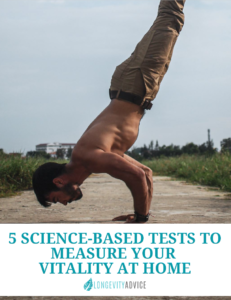Note: This article on stability and longevity is a guest post from friend-of-the-site Troy Delaney while Rachel continues her maternity leave. Troy runs several great longevity Facebook groups, writes about longevity supplements and interventions on his personal blog, and also offers coaching services for people interested in becoming healthier with a focus on longevity and resilience. Go give his stuff a follow!
As I creep into my mid-40s, I’m realizing important aspects of the aging process not commonly talked about but critical for healthy aging. One of those aspects is stability, a key factor that significantly influences our quality of life and well-being as we age.
Think about this – the one-year mortality rate after a hip fracture is estimated to be between 14% and 58%. And the risk of mortality increases by 4% each year for the elderly population. What’s more, it is estimated that up to 40% of injury-related deaths, and 1% of total deaths in those aged 65 and over, are due to falls.
If you’re under 65, you may not think this is a big deal, but we need to address this before it becomes a problem. And stability goes beyond the physical aspect.
In this article, I’ll review exactly what stability is, why it’s important and how to develop strong stability in aspects of your life.

Stability for longevity
One component and the most common form of stability is the subconscious ability to harness, decelerate, or stop force. It’s what allows us to transmit force from our body to the outside world and receive force from the outside world to our body. It’s our body’s way of transferring force efficiently and safely through good movement patterns.
But stability can be more than just physical. It can also encompass a range of mental, and emotional aspects that play a crucial role in healthy aging as well. From maintaining balance and mobility to fostering resilience and emotional well-being, stability forms the foundation upon which a fulfilling and vibrant later life is built.
Unfortunately, stability for longevity can’t be measured like other physical fitness pillars like VO2max or strength. It’s much more about feel. This involves mastering your movement patterns, becoming more internally stable and developing a strong connection to your mental state. This will not only fix injuries but also prevent injuries and long-term mental and physical pain, which is the ultimate goal of longevity. Being stable and having the ability to harness your strength is exactly what we have to do as we age.
The importance of stability for healthy aging
- Physical balance and mobility: Physical stability is fundamental for maintaining balance, mobility, and proper movement patterns, all essential for performing daily activities, preventing falls and injuries. As we age, changes in muscle strength, joint flexibility, and sensory perception can affect balance. Improving and maintaining physical stability through targeted exercises and activities can help reduce the risk of falls and injuries.
- Emotional resilience: Emotional stability and resilience are key components of mental well-being in older adults. Facing life transitions, health challenges, or loss can be emotionally challenging, and maintaining stability in emotions can contribute to better coping mechanisms and overall psychological health. Exposure to discomfort in a controlled environment (think purposeful cold exposure), can build emotional resilience.
- Cognitive function: Cognitive stability involves maintaining mental clarity, focus, and memory as we age. Strategies such as cognitive exercises, stimulating activities, and a healthy lifestyle can support cognitive stability and delay cognitive decline.
- Social connectedness: Social stability refers to the quality of social relationships and support networks. Maintaining stable and positive social connections with friends, family, and communities can contribute to mental and emotional well-being, reduce feelings of loneliness, and provide a sense of belonging.
Strategies to Enhance Stability for Healthy Aging
- Breathing: This is the foundation to stability. It includes the physical benefits through intraabdominal pressure, which supports movement of limbs and rotation but also includes the emotional aspect through breathing exercises that reduce stress.
- Physical activity: Engage in regular physical activity that includes strength, balance, and flexibility exercises. Activities like yoga, tai chi, and resistance training can improve muscle strength, balance, and coordination.
- Mindfulness and stress management: Practice mindfulness techniques, meditation, and stress-reduction strategies to promote emotional stability, resilience, and a positive outlook. Again, breathing exercises are key.
- Social engagement: Stay connected with friends, family, and social groups. Participate in social activities, volunteer work, or join clubs and organizations to foster social stability and a sense of community.
- Regular health check-ups: Schedule regular health check-ups and screenings to monitor and manage any health conditions. Addressing health issues promptly can contribute to overall stability and well-being. Pay particular attention to movement patterns that may be causing pain and address those immediately before they become a bigger problem.
- Lifelong learning: Stay mentally active and engaged through lifelong learning, hobbies, creative pursuits, and intellectual challenges. Stimulating the mind can help maintain cognitive stability and mental acuity.
A great way to test physical stability (along with mobility and strength) is the Sitting-Rising Test (SRT). Give it a try! (J.P.: and it’s one of the at-home vitality tests we’ve included in our free guide here at Longevity Advice!).
Stability forms the cornerstone of healthy aging, encompassing physical, mental, emotional, and social aspects. By prioritizing strategies to enhance stability across these domains, High Performance Agers (as I all them) can enjoy a more resilient, active, and fulfilling life, maintaining independence and pain-free longevity.
 Troy Delaney is the founder of Antifragile.Fit and writes on his personal blog My Wife Thinks I’m Crazy But It Works. He is a full time Health Systems Engineer at the Mayo Clinic and in his spare time, a Human Optimization Coach, teaching breath training, land and water workouts and contrast therapy (hot and cold exposure). Troy’s true specialty lies in finding unconventional, and often disruptive, solutions to impediments to achieving maximum potential, whatever your goal may be.
Troy Delaney is the founder of Antifragile.Fit and writes on his personal blog My Wife Thinks I’m Crazy But It Works. He is a full time Health Systems Engineer at the Mayo Clinic and in his spare time, a Human Optimization Coach, teaching breath training, land and water workouts and contrast therapy (hot and cold exposure). Troy’s true specialty lies in finding unconventional, and often disruptive, solutions to impediments to achieving maximum potential, whatever your goal may be.
I’m the co-founder of Longevity Advice and have been passionate about radical life extension ever since I was a teenager. Formerly I was a content marketing director in the B2B software space. I’m also a sci-fi novelist, wargame rules writer, and enthusiast for cooking things in bacon fat. My sister once called me “King of the Nerds” and it’s a title I’ve been trying to live up to ever since.



 Subscribe for our free guide!
Subscribe for our free guide!